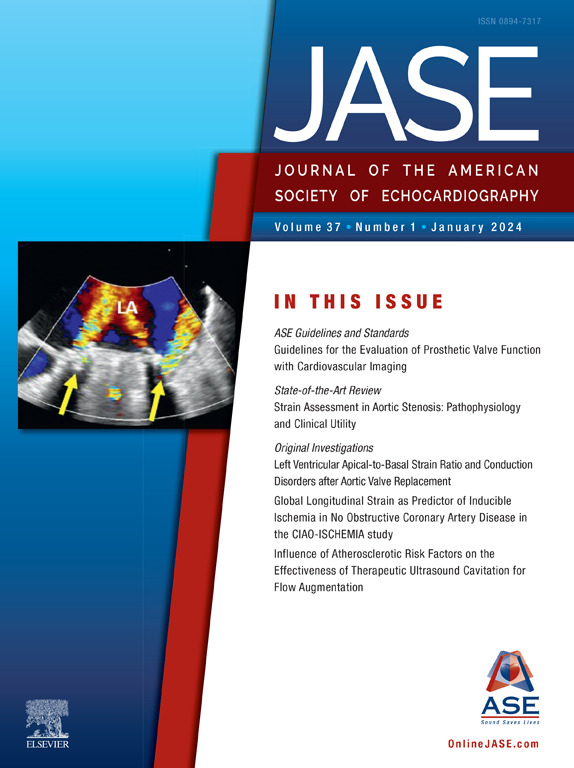Multimodality Imaging in Presurgical Evaluation of Total Anomalous Pulmonary Venous Connection: Single-Center Practice Variability and a Systematic Review of Diagnostic Error
IF 6
2区 医学
Q1 CARDIAC & CARDIOVASCULAR SYSTEMS
Journal of the American Society of Echocardiography
Pub Date : 2025-10-01
DOI:10.1016/j.echo.2025.05.020
引用次数: 0
Abstract
Background
Pulmonary vein anatomy varies widely in total anomalous pulmonary venous connection (TAPVC), with diagnostic accuracy affecting surgical planning and prognosis. Echocardiography is the preferred screening modality. Cross-sectional imaging (cardiac computed tomography [CT] or magnetic resonance [MR]) may offer added value.
Methods
As the first step in a quality improvement initiative, we sought to describe practice patterns in presurgical imaging in TAPVC with attention to diagnostic error. We also evaluated the available literature on diagnostic accuracy of imaging in TAPVC. Patients with TAPVC who underwent repair at our center (January 1, 2006, to September 15, 2022) were included.
Results
Thirty-three of 167 patients (20%) underwent presurgical CT or MR. Initial echocardiogram incorrectly diagnosed the subtype of TAPVC in 9% (15/167). Patients with birth weight under 3 kg, born preterm, or with an initial diagnosis of mixed-type TAPVC were more likely to have misdiagnosis by initial echocardiogram. Computed tomography or MR miscategorized 3/33 patients. A systematic literature review revealed 10 studies that evaluated CT imaging diagnostic accuracy in TAPVC, one of which also included MR studies. Among 171 total patients, there were no patients with inaccurate anatomic diagnosis by CT or MR.
Conclusions
Cross-sectional angiography is used increasingly in this population and with diagnostic excellence, although it is not infallible. Efforts to improve echocardiographic quality as well as multimodality imaging in high-risk patients may improve diagnostic accuracy and surgical planning.
多模态成像在术前评估完全异常肺静脉连接:单中心实践变异性和诊断错误的系统回顾。
全肺静脉异常连接(TAPVC)的解剖结构差异很大,其诊断准确性影响手术计划和预后。超声心动图是首选的筛查方式。横断成像(心脏计算机断层扫描(CT)或磁共振(MR))可能提供附加价值。作为质量改进的第一步,我们试图描述TAPVC手术前成像的实践模式,并关注诊断错误。我们还评估了有关TAPVC影像学诊断准确性的现有文献。我们纳入了在我们中心(1/1/06-9/15/22)进行修复的TAPVC患者。167例患者中有33例(20%)接受了术前CT或mr检查,9%(15/167)的超声心动图错误诊断了TAPVC亚型。出生体重低于3kg、早产或初诊为混合型TAPVC的患者,初诊超声心动图更容易误诊。3/33例CT或MR误诊。系统文献回顾显示,有10项研究评估了CT成像诊断TAPVC的准确性,其中一项研究还包括MR研究。在171例患者中,没有患者的CT或mr解剖诊断不准确,横断血管造影在这一人群中越来越多地使用,诊断效果也很好,尽管它不是绝对正确的。努力提高超声心动图质量和多模态成像在高危患者可能提高诊断的准确性和手术计划。
本文章由计算机程序翻译,如有差异,请以英文原文为准。
求助全文
约1分钟内获得全文
求助全文
来源期刊
CiteScore
9.50
自引率
12.30%
发文量
257
审稿时长
66 days
期刊介绍:
The Journal of the American Society of Echocardiography(JASE) brings physicians and sonographers peer-reviewed original investigations and state-of-the-art review articles that cover conventional clinical applications of cardiovascular ultrasound, as well as newer techniques with emerging clinical applications. These include three-dimensional echocardiography, strain and strain rate methods for evaluating cardiac mechanics and interventional applications.

 求助内容:
求助内容: 应助结果提醒方式:
应助结果提醒方式:


